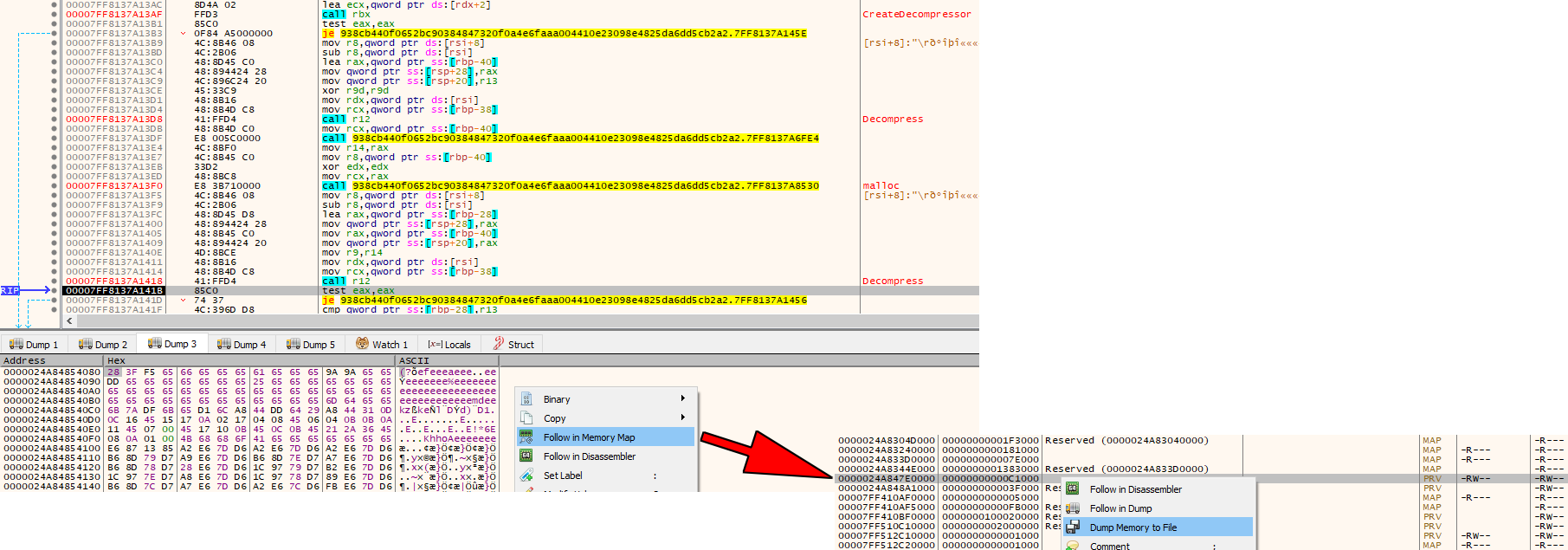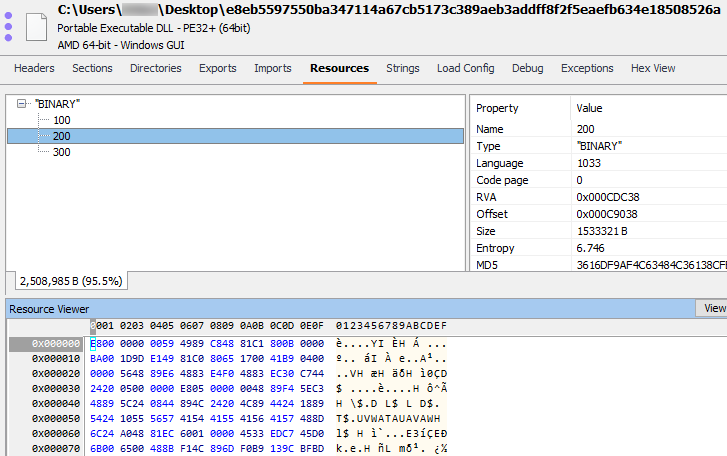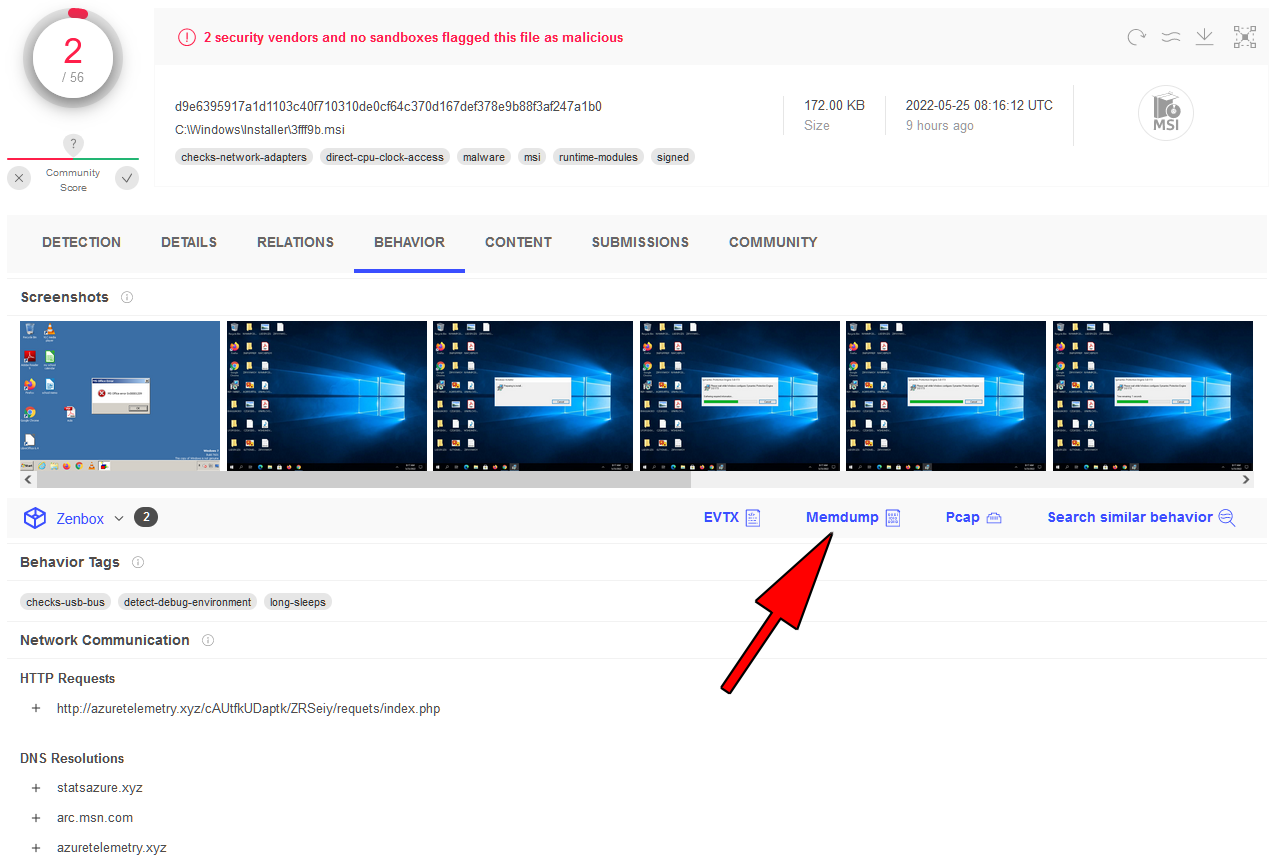Introduction of a PE file extractor for various situations
During a malware analysis, you may encounter the situation where a next stage payload is loaded or injected into another process. When this is the case, usually a raw PE file gets decrypted in memory that is used to build the memory module. The trick is to find the procedure which decrypts the raw file with a debugger and dump the memory region which contains this payload. This allows you to easily extract the original PE file from the dump for further analysis. Thus, you usually don’t need to perform contorts like dumping the memory module of the payload and rebuild its import address table.
When I don’t extract a payload by hand, I’ve always used the combination of a debugger and PEExtract. In most cases, PEExtract works correctly and grabs the PE payloads. However, it has a few shortcomings like no support for signed PE files and its development also stopped in 2007. That’s why I’ve created pe_extract.py to overcome those issues. While there are already scripts like this (e.g. pe-carv), I’ve added a few improvements and features:
- Multiple file scan support (e.g. for automatically created memory dumps)
- Skip likely incomplete page sized PEs (for automatically created memory dumps)
- Support for XORed PE files
Use case 1 - Extract payload(s) from a manual memory dump
Typical usage: python pe_extract.py <FilePathToDump> (--extract-xored)
As an example, let’s take a Cobalt Strike loader I dubbed FlyingTurtleLoader after its internal name FlyingTurtle. The initial 64-bit DLL is a loader for a first stage EXE which in turn is the final loader for the Cobalt Strike beacon. Each stage is base64 encoded, MSZIP compressed and the first stage additionally XOR encrypted.
Malware (SHA-256):
938cb440f0652bc90384847320f0a4e6faaa004410e23098e4825da6dd5cb2a2
As initially described, when you analyze a loader or multi-stage malware sample, there’s usually a raw PE file written to a memory buffer at some point. The following x64dbg screenshots show the XOR encrypted first stage EXE payload in the Dump 3 window:
At this point, you can already go to the memory region that contains the encrypted payload (Follow in Memory Map) and save it to disk (Dump Memory to File). You don’t even need to find the final routine which decrypts the payload (XOR bytes with 0x65), as this can be done by pe_extract.py. You just need to run the script with the --extract-xored argument and it extracts the decrypted final loader. According to its PDB path and the empty Cobalt Strike config data, this is a test tool:
C:\test\FlyingTurtle\x64\Release\FlyingTurtle.pdb
Use case 2 - Extract payload(s) from on-disk file(s)
Typical usage: python pe_extract.py <FilePathToDump> --extract-xored (--extract-overlays)
Sometimes, there is malware that keeps one or more payloads unencrypted in its PE sections. Or the payloads are encrypted with a simple XOR algorithm. When this is the case, you can easily extract them and make a initial assessment what the purpose of the malware might be by looking at them. For PE extration, this is the best case because the embedded files can be pulled out reliably.
Again, as an example, we use a Cobalt Strike loader I dubbed K32Loader according to this specific API function that it uses called K32GetProcessImageFileNameW. It disguises itself as a legitimate looking Windows file and keeps other legit signed files along with the actual Cobalt Strike beacon loader in its resources section. The legit files do not serve any purpose except to make the malware look less suspicious. The final beacon loader DLL is run by a shellcode created with the help of sRDI. The final loader contains the AES encrypted Cobalt Strike beacon.
Malware (SHA-256):
2016258b9aea66a204a4374aeef2d5f7a0c6857ee92491a12440ce8487aaf938 (Sample 1)
6344b05fe37649d87617e5ba26cd90a3d9b4bff28904df89a6b9028265c9db65 (Sample 2)
e8eb5597550ba347114a67cb5173c389aeb3addff8f2f5eaefb634e18508526a (Sample 3)
The sample’s embedded files are described in the following table:
| Sample | Stages | Initial DLL masked as | Initial DLL signed files | 1st stage DLL masked as | 1st stage signed files | Final DLL loader name |
|---|---|---|---|---|---|---|
| 1 | 2 | Windows MsMpRes.dll |
Windows MsMpRes.dll |
Not masked (internal name final-load.dll) |
- | Protections-Remover.dll |
| 2 | 1 | Windows userenv.dll |
Windows MsMpRes.dll |
-> | -> | final-load.dll |
| 3 | 2 | Windows userenv.dll |
Sophos ICManagement.dll, DetectionFeedback.dll |
Not masked | Windows MessagingDataModel2.dll, midimap.dll |
astraGem.dll |
The following EXE Explorer screenshot shows the embedded files in sample 3:
The resources named 100 and 300 are the signed ICManagement.dll and DetectionFeedback.dll files from Sophos. The resource named 200 is the reflective loader shellcode with the embedded Cobalt Strike loader named astraGem.dll. This file contains the additional signed Windows files MessagingDataModel2.dll and midimap.dll in its resource section.
When we use pe_extract.py on each file, we get all the unencrypted embedded files except for the Cobalt Strike beacon as it’s encrypted.
Beacon domains:
dns.minimephotos[.]co.uk
orchardstanks[.]com
bellennium[.]com
energy-sciences[.]org
Use case 3 - Extract payload(s) from automatically created memory dumps
Typical usage: python pe_extract.py <FolderPathToDumps> (--extract-overlays) (--extract-all)
Nowadays, more and more sandboxes contain the ability to scan for malware in memory. Usually, this is done by dumping memory images to disk and scan those for any malware patterns. Based on the quality of the mechanism that triggers the dump procedure, you have a bigger or smaller amount of dump files that hopefully contain one or more (decrypted) payloads. One such a sandbox is Virustotal’s Zenbox that is capable of creating memory dumps during a sample analysis.
As an example, we use a Matanbuchus sample.
Malware (SHA-256):
d9e6395917a1d1103c40f710310de0cf64c370d167def378e9b88f3af247a1b0
It’s a signed MSI file disguised as a Symantec Protection Engine installer and contains two files. The first file named notify.vbs shows a fake error message when run. The second file named main.dll is a signed Matanbuchus loader disguised as a Visual Studio installer. The signatures are as follows (MSI file on the left, main.dll on the right):
The following Virutotal screenshot shows the option to download the memdump of this file:
Unfortunately, this feature is limited to enterprise accounts.
In this extraction case, just provide the folder path which contains the memory dumps as an argument and pe_extract.py scans each file for embedded PEs. When we do that, we get five extracted DLLs. From the FDMP files, we have two versions of main.dll with the signature information cut. From the SDMP files, we have an additional version of main.dll with a cut signature and two versions of the main Matanbuchus module.
The first main module file is the raw PE decrypted during the loading routine (see introduction). It contains the usual Matanbuchus strings in cleartext:
Agent.ADNJ
Agent.Matanbuchus
B:\Loader\Matanbuchus\Main module\Belial project\MatanbuchusLoader\MatanbuchusLoaderFiles\Matanbuchus\json.hpp
The second main module file is a memory dump of the raw PE that contains additional (decrypted) strings:
azuretelemetry.xyz
/cAUtfkUDaptk/ZRSeiy/requets/index.php
statsazure.xyz
23.227.196.227
87.236.146.125
icLJkdnBDX
qmG
Running exe
Starting the exe with parameters
High start exe
RunDll32 & Execute
Regsvr32 & Execute
Run CMD in memory
Run PS in memory
MemLoadDllMain || MemLoadExe
MemLoadShellCode
MemLoadShellCode #2
Running dll in memory #2 (DllRegisterServer)
Running dll in memory #3 (DllInstall(Install))
Running dll in memory #3 (DllInstall(Unstall))
Crypt update & Bots upgrade
Uninstall
Gp
Pk
vM
Vs
bN
Jb
NSeyDX
Los
wP6
cBF
Vz
3m7x
ELj
Eo6
Q6X6
tW
acG
3CEk
DS2x
Fto
f1da
3fe11
zkC7
These strings were obfuscated at compile time. They get only revealed when the string decryption procedures are executed during the (C++) initialization phase. You can see the decrypted strings in the .data section when you set a breakpoint on DllMain and run the raw PE sample in a debugger. This obfuscation method was introduced several years ago in a project called ADVobfuscator.
We can see a few additions by examining those strings and comparing them to the previous version. A new memory shellcode loading mechanism (MemLoadShellCode #2) appears to be the most obvious new feature.
We can also see some strings that were decrypted using a different method:
Agriel
v1.4.0
DAN03
%02X-%02X-%02X-%02X-%02X-%02X
%USERDOMAIN%
User
Admin
kernel32
IsWow64Process
32 Bit
64 Bit
%LOGONSERVER%
POST
HTTP/1.1
Host:
User-Agent:
Windows-Update-Agent/11.0.10011.16384 Client-Protocol/2.0
Content-Length:
Content-Type: application/x-www-form-urlencoded
Accept-Language: en-US
Matanbuchus domains:
statsazure[.]xyz
azuretelemetry[.]xyz
Conclusion
With pe_extract.py you have a tool that can save you some time during a malware analysis session and make things easier. It speeds up the analysis process a bit and can help make a first assessment of an unkown malware. It can also be useful to create Yara rules, especially when the retrieved PE file comes from a memory dump and contains decrypted data. This information is a goldmine for in-memory detection signatures.
Script download
pe.extract.py can be found on my Github page: pe_extract
 R136a1
R136a1


